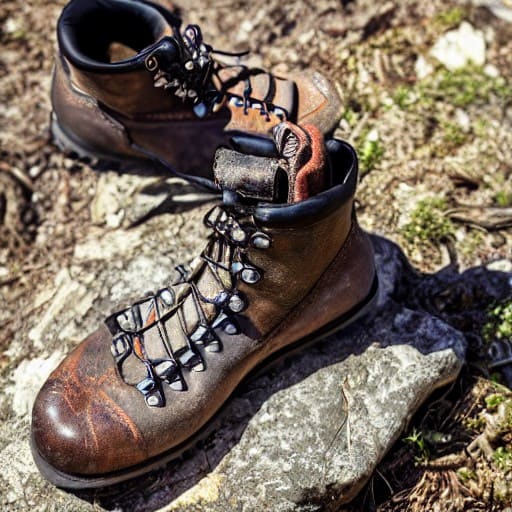Table of Contents
Some links on posts are affiliate links and will earn us a commission from qualifying purchases
Hiking boots are an essential piece of gear for any hiker, whether you’re a beginner or a seasoned pro. But with all the different brands, materials, and styles on the market, it can be tough to know where to start. And once you’ve found a pair you like, there’s still one more important decision to make: what size to buy.
Size is arguably the most important factor to consider when buying hiking boots. If they’re too small, your feet will be cramped and uncomfortable; if they’re too big, your feet will slide around inside and you’ll risk getting blisters. So how can you be sure you’re choosing the right size?
When buying hiking boots it’s always better to err on the side of caution and choose a boot that’s slightly larger than your actual foot measurement. This will give you more room to move your feet and will make the boots more comfortable. Follow our tps below to get the perfect fit.
What to look for when it comes to size when buying hiking boots
As a beginner hiker, it’s important to know what to look for when buying hiking boots. Size is one of the most important factors, as you don’t want your boots to be too tight or too loose.
How to Measure Your Feet
One of the most important things to keep in mind when shopping for hiking boots is that they should fit snugly but not be too tight. To find the right size, you’ll need to measure your feet. Here’s how:
- Use a tape measure or ruler to find the length and width of your foot. Length is measured from the heel to the toe, while width is measured from side to side at the widest part of your foot.
- If you don’t have a tape measure or ruler handy, you can also trace your foot onto a piece of paper and then use a ruler or tape measure to find the length and width.
- Once you have those measurements, consult a size chart to find the corresponding boot size.
Try Them On In-Store (If Possible)
The best way to ensure you’re choosing the right size hiking boots is to try them on in person at a bricks-and-mortar store. That way, you can get a feel for how they fit and see if they’re comfortable.
If you’re not able to do that—for example, if you’re buying online—don’t worry. Many retailers have policies in place that allow you to return or exchange items that don’t fit, so long as you do so within a certain timeframe (usually 30 days). Just be sure to check the retailer’s return policy before making your purchase.
How to Test for Fit
One way to test for fit is to put on the socks you’ll be wearing on your hike and then try on the boots. Once you have the boots on, lace them up and walk around for a few minutes to see how they feel. If they feel good, then you’ve found a winner! But if they don’t feel quite right, it’s best to keep looking.
Another way to test for fit is to take advantage of boot-fitting services at outdoor stores. These services can help ensure that you’re choosing the right size hiking boots for your feet.
Know Your Shoe Size… But Also Consider Going Up or Down a Size
Even if you’ve been wearing the same shoe size for years, it’s always a good idea to double-check before ordering hiking boots. The reason is that different brands can run slightly large or small, so what might typically be a comfortable fit in one brand may be slightly too snug or too roomy in another.
When in doubt, it’s better to err on the side of caution and choose a size up from your usual. That way, you’ll have plenty of room to wiggle your toes and won’t risk getting blisters. And if the boots are too big? You can always try tightening up the laces or wearing thicker socks. On the other hand, if they’re too small, there’s not much you can do except send them back and start again from scratch.
Why buy a size bigger boot?
There are several reasons why you might want to consider buying a size bigger boot. First, it provides more room for your feet to move around. This can be important if you’re hiking long distances or if you have wide feet. Second, it allows you to wear thicker socks without your toes being crammed into the toe box. This can be important in cold weather when you need to layer up to keep your feet warm. Finally, it gives you the option to use footbeds or insoles for added cushioning and support.
What about width?
When it comes to width, you want to make sure that your boots aren’t too tight or too loose. If they’re too tight, they can cause blisters and rub your feet raw. If they’re too loose, they can cause heel slippage and lead to foot pain further down the trail. The best way to ensure a good fit is to try on boots with socks that are similar in thickness to what you’ll be wearing on the trail.
More Room to Move Your Feet
One of the main benefits of choosing a bigger size hiking boot is that you’ll have more room to move your feet. This is especially important if you’re going to be doing a lot of walking or hiking. If your feet are cramped inside your boots, they’re more likely to get tired and sore. However, if you have plenty of room to move your feet, they’ll stay more comfortable even after hours of walking.
Better Support for Your ankles
Another reason to choose a bigger size hiking boot is that it will provide better support for your ankles. This is especially important if you’re going to be doing any off-trail hiking where the terrain might be uneven. Having a boot that’s too small can leave your ankles vulnerable to sprains and other injuries. However, if your boots are too big, they might rub and cause blisters. Choosing a size that’s just right will give you the best combination of support and comfort.
They’ll Be Easier to Break In
Hiking boots usually need to be broken in before they’re truly comfortable. And if they’re too tight, this process can be even more difficult. But if you choose a bigger size, the breaking-in process will be much easier—and quicker. You won’t have to spend hours walking around in uncomfortable shoes before they start feeling better.
How to Choose the Right Style
- In addition to finding the right size, you’ll also want to make sure you choose a style that’s well-suited for your needs. Here are some things to keep in mind:
- Do you need a waterproof boot? If you’re planning on doing any hiking in wet or humid conditions, it’s a good idea to choose a waterproof boot. Waterproof boots are made with special materials (like Gore-Tex) that help keep your feet dry even when walking through puddles or Mud.
- Are you looking for extra support? If you have flat feet or high arches, you may want to choose a boot with more support. Look for features like reinforced midsoles and extra padding around the ankles.
- Do you need a light-weight boot? If you’re planning on doing any backpacking, it’s important to choose a light-weight boot that won’t add too much weight to your pack.
- Do you need extra traction? If you’ll be doing any hiking in snowy or icy conditions, it’s a good idea to choose a boot with extra traction (like ones with built-in crampons).
How to Deal With Ill-Fitting Hiking Boots
Whether they’re too tight or too loose, it can be a real pain (literally!) to try and hike in boots that don’t fit properly. If you find yourself in a situation where your hiking boots are either too tight or too loose, don’t despair – there are a few things you can do to make them more comfortable.
How to Tell if Your Hiking Boots Are Too Tight or Too Loose
When you’re lacing up your hiking boots, it’s important to make sure they fit properly. Here are a few signs that will help you determine whether your hiking boots are too tight or too loose:
- If your toes feel cramped, pinched, or jammed, your boots are probably too small.
- If you can feel hotspots or blisters forming on your feet, your boots are definitely too small.
- If your heels slip when walking downhill, your boots might be too big.
- If you have to cinch the laces so tight that they cut off circulation to your feet, your boots might be too big.
- If you can fit more than one finger behind your heel when the boot is laced up, your boots are probably too big.
- If you constantly find yourself having to stop and readjust your socks or re-tie your laces, it’s likely that your boots don’t fit properly.
If Your Hiking Boots Are Too Tight…
If your boots are too tight, the first thing you should do is try to loosen them up. You can do this by unlacing them completely and then relacing them using a looser knot. If that doesn’t work, you can try wearing thicker socks or putting on golf socks over your regular socks. This will help to fill up any extra space and make the boots feel snugger. If your boots are still too tight after trying these things, you may need to buy a different pair of boots altogether.
If Your Hiking Boots Are Too Loose…
If your boots are too loose, there are a few things you can do to tighten them up. First, try lacing them up tighter than usual. If that doesn’t work, you can try wearing two pairs of socks (one thin pair and one thick pair). This will help to fill up any extra space and make the boots feel snugger. You can also try tying a bandana around your ankle or calf to help hold the boot in place. If your boots are still too loose after trying these things, you may need to buy a different pair of boots altogether.
If your hiking boots are too big, try wearing thicker socks and cranking down the laces. This will give you a snugger fit and help prevent blisters. You can also try using lace locks or shoe trees to take up some of the extra space in the toe box.
Conclusion: should walking boots be a size bigger?
Choosing the right size hiking boots is essential for a comfortable hike—but it doesn’t have to be difficult. By following our simple tips above, you can rest assured that your new boots will fit like a glove (or close enough). Happy shopping!
Related posts
Do you love hiking, but find that your boots always seem to rub your ankles the wrong way? If so, relax – you’re not alone. In fact, this is a common issue that many hikers face. Fortunately,...
Choosing The Best Shoes And Boots For Walking - a complete guide
Before buying your next pair of walking shoes or boots check out this guide which will answer the questions you may have


